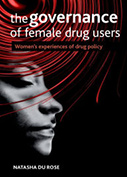The Governance of Female Drug Users: Women’s Experiences of Drug Policy

Author: Natasha Du Rose
Publisher: Bristol, UK: Policy Press (distributed in the U.S. by University of Chicago Press), 2015. 224p.
Reviewer: Nancy D. Campbell | May 2016
This book presents an account of women’s agency, their experiences of pleasure and pain in drug-using social worlds, from the partisan perspective of an advocate. Du Rose does not neglect the structural literature as much as use it to recreate the edifice of governance in the United Kingdom, the United States, and Canada. The edifice thus erected is the “official discourse” of drug policy that Du Rose analyzes in order to demonstrate how “female drug users” are positioned as problems to be managed, as de facto lawbreakers, as criminal perpetrators who have at best succumbed to a disease and at worst as “`bad,’ dangerous, irresponsible, immoral, criminal women who cause harm to young people, families, and communities” (p. 265).
Where others see criminality, the inexorable progress of addiction, or uncontrollable urges that erode women’s agency, Du Rose sees women who are pragmatically escaping structural as well as individually-directed violence. Her subjects, 40 women from three cities in the United Kingdom, who use heroin, antidepressants, crack-cocaine, and a variety of other legal and illegal substances, tell her the stories of their lives. Rather than attempt an ethnography designed to gain the effect of realism, Du Rose pursues the ambitious goal of letting these women speak their truths after setting up a conceptual framework based on discursive analysis. That discourse has material effects is not a new insight in the domain of drug-using women, but Du Rose’s interviews provide empirical depth that adds dimension to work on feminist policy discourse in the drugs domain. Not until readers are halfway through the book, however, does Du Rose begin to make good on the promise to delve into the experiences and subjectivities of her subjects.
First, she tells policy stories deemed necessary for contextualizing her project—the criminalization of British drug policy, following upon the global dominance of the United States in setting the criminalizing tone of prohibition. Recent historiography on British drug policy is surprisingly absent from the bibliography.
Mapping the early feminist work on the topic, Du Rose positions her work in solidarity and continuity with ethnographies such as those of Marsha Rosenbaum, Eloise Dunlap, etc., who presented drug-using women as rational agents pursuing “moral careers” in order to cope with the ever-narrowing options and relentless regularity of trauma which they met in drug economies. Du Rose also considers the recent literature on ‘risk society’ and the gendered differentials in responsibilities to avoid risk and reduce harm (p. 57). Adopting the frame of neoliberalism as a mode of governance relevant for understanding the experiences and subjectivities of female drug users, Du Rose understands risk as central to the political terrain that she and her subjects are navigating.
This is partisan research. Du Rose unabashedly regards the “publication of research findings as a political act” (p. 49). Indeed, the social research process is among the “technologies of power” that govern drug-using women’s lives. Her political landscape is a stark one, inhabited by unpunished perpetrators and ‘victims’ who are denied even the status of victimhood due to an overpowering apparatus of governance. Similarly, the account of medicalization is one of sheer social control. Grounded in the disease model of addiction, of which the author is scathingly critical, medicalization is called out only for those aspects that facilitate and reinscribe punishment.
While there are historical convergences and collusions between medicalization and criminalization, they are not the same. Both are stratified in racial, ethnic, and gender terms. At times Du Rose’s outrage is palpable on the page, which leads readers to wonder about the reliability of some of the empirical basis of the analysis. Does the effect cloud the author’s judgment in terms of what to present of the interviews? For instance, the section on methadone maintenance is particularly dated and biased. Is all attention to addiction therapeutics nothing more than social control? Buprenorphine and other modalities such as therapeutic communities go unmentioned, and the methadone examples are what I might call “stingy methadone” delivered within a framework that shifts the locus of control from women to the enforcers of methadone rules and regulations. Altogether, the discussion of methadone is reductive—another iteration in the loss of autonomy that these women experience in relation to medicalization.
Du Rose argues that the subjectivities (and hence the experiences) of women drug users are produced and shaped by three “technologies of power” that govern their situations: 1. prohibition (criminalization); 2. medicalization; and 3. welfarization. These “technologies” (one might also see them as social processes) serve as the major orienting features of the book. By far the major contribution of this book to the body of work on the impact of drug policy on women are the chapters that present the “psychosocial accounts” and “social stories” of the interviewees. Du Rose does an excellent job demonstrating how her subjects have internalized the disease model in ways that lead them to blame themselves for the high levels of structural and interpersonal violence that pervade their lives. At times, long lists of findings and sample sizes are interspersed with less connective tissue than I would have liked to see in the prose, suggesting that the book moved rapidly from dissertation to publication. But then the reader is presented with a compelling accumulation of ‘normalizing’ accounts that converge with the technologies of governance. These accounts are replete with detail, offering rich, thoughtful, articulate commentary on the damage that drug policy has wrought in women’s lives.
The last content chapter makes a nuanced case for resistance amidst the governing mentalities of discourse on drugs. This chapter examines precisely how “technologies of the self” dovetail with “technologies of power” to shape women’s experiences of themselves and others, including public programs that are essential to their support. Du Rose enumerates three such technologies of the self and illustrates each. These are: ascription of characteristics, often through “expert” discourse; normalization; and responsibilization. All of these rely on the subject to internalize the regulatory discourse. Among such “authoritative” demands are constructions of drug-using women as irrational, irresponsible, weak-willed, and callous.
Regarding women as resourceful, rational, adaptive, and caring, Du Rose insists that they are “rational governors of their pain.” By separating their “true selves” from their “addict selves,” participants in the study salvaged their ambivalence and transformed it into dignity. In an exemplary quote (p. 266), Du Rose writes of this process: “However, resisting official constructions, they did not see themselves as victims or criminals, but as adaptive, rational, and resourceful women, responsibly governing their pain and providing for their partners and children.” Indeed, it seemed to Du Rose that male partners acted in ways that were far more ‘parasitic’ towards mainstream society than did the women she interviewed.
There are contrasts between Du Rose’s approach and those of other scholars working ethnographically with similar subjects or on sociologically similar topics. For instance, Jill A. McCorkel’s Breaking Women: Gender, Race, and the Politics of Imprisonment (New York University press, 2014) demonstrates how treatment technologies aimed at ‘self-transformation’ are deployed in U.S. women’s prisons in order to compel women to accept and reproduce a view of themselves as ‘addicts’ that was based on the philosophy “break ‘em down to build ‘em up.” Kelly Ray Knight’s ethnography of women working in the daily rent hotels of San Francisco,addicted.pregnant.poor (Duke University Press, 2015) revealed subjects who defied easy classification into villain or victim, perpetrator or plaintiff. Tammy Anderson’s edited volume Neither Villain Nor Victim: Empowerment and Agency Among Women Substance Abusers(Rutgers University Press, 2008) also unsettles the categories that emerge yet again in Du Rose’s book.
This is a valuable effort — the ongoing documentation of the distance between drug policy discourse and the lived realities described by women who are simultaneously navigating their “desire to be ‘normal’” and their “alienation from the ‘straight world’” (p. 267). While there is little in the conceptual framework that will surprise readers, this is a well-written, thorough account from women who inhabit social worlds that remain deeply misunderstood.
Nancy D. Campbell, Professor of Science and Technology Studies at Rensselaer Polytechnic Institute in Troy, New York, is the author ofUsing Women: Gender, Drug Policy and Social Justice (Routledge, 2000) and co-author with Elizabeth Ettorre of Gendering Addiction: The Politics of Drug Treatment in a Neurochemical World (Palgrave, 2011).


